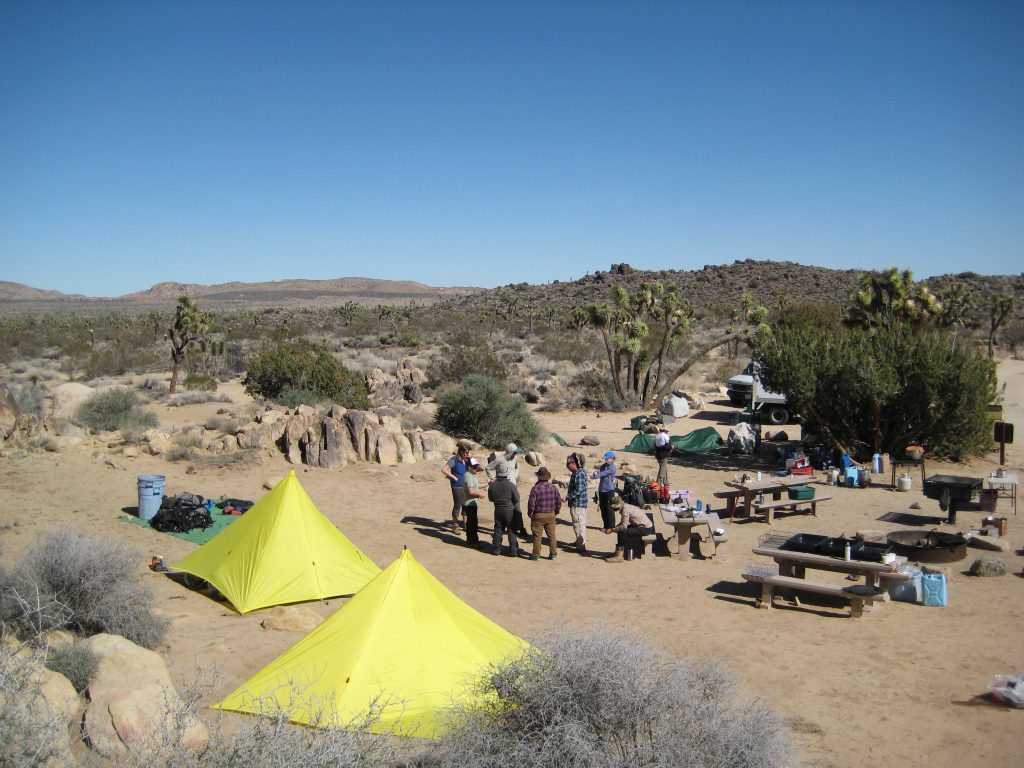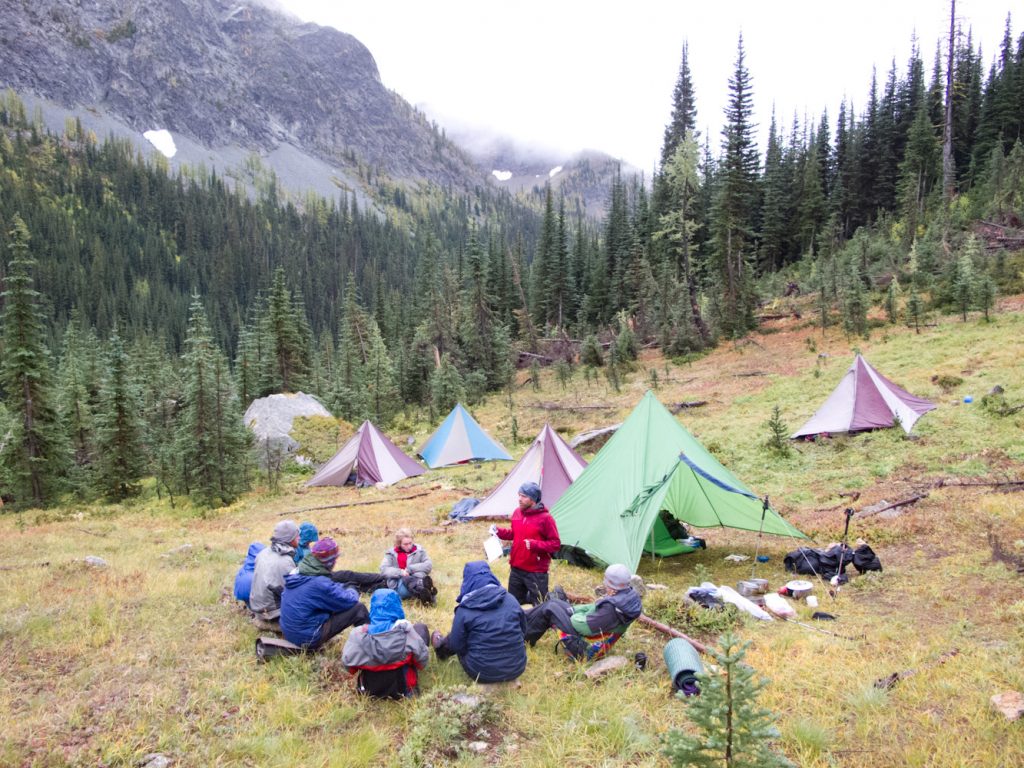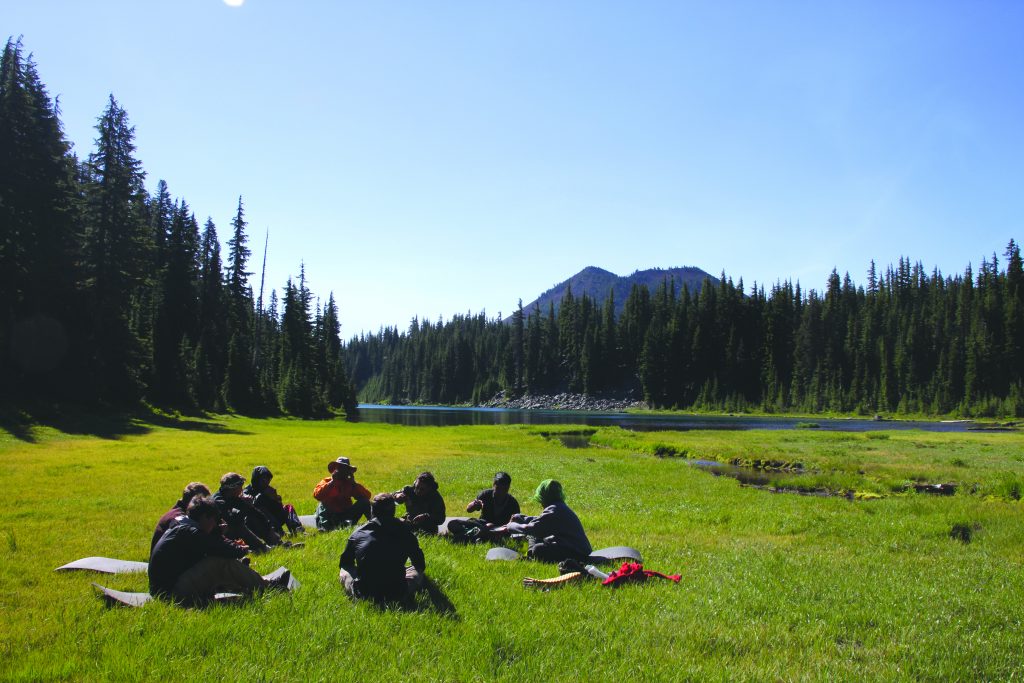Visualize this. You’ve just spent a long day backpacking with your crew. It’s hot out, you’re hungry and all you want to do is sit down, take off your shoes and relax on your sleeping pad. But first, you must choose a campsite. You try to lead a discussion with your crew on where to camp, but half of your group is too tired to care, and a few have really strong opinions that they won’t voice now, but will as soon as a decision is reached. Choosing a good campsite doesn’t have to be stressful, especially when keeping the following strategies in mind.

A crew gathers together after a day of traveling to make a plan for what to do next at their campsite.
- Start early and scout. Look for a campsite within a mile of your preferred stopping point for the day. While I’m on the trail, I scan the area for clearings and flat spots off in the distance that could make a good camp. Once I get to the day’s end point, I set my pack down and go for a scout.
- Respect others and the natural world. I like to think of consciously impacting the world around me. We’re always going to leave an impact on each other, so I like to find my campsite with that in mind. Camp close, but not too close to water and trails (about 200 feet or 75 steps). Keep the campsite convenient to a water source, but tread lightly and camp away from it. This allows other users to benefit from the access and keeps it open to wildlife. Camp on durable surfaces: like on a patch of dirt next to a meadow, rather than in the meadow among the wildflowers. Consciously selecting a site will take time to find, and it’ll be more enjoyable if you set down your pack to take a look.
- Seek to follow nature’s lead and blend. Work with nature, not against it. I like to camp away from trails in a tent that mimics the colors of my area, so I can preserve the visual landscape. Humans and animals alike are sensory creatures and we seek outdoor experiences to escape the loud sensory input of our daily lives.
- Keep it safe and follow an attitude of precaution. I scan my prospective campsite for dead trees with precarious limbs that could fall with a sudden gust of wind. If I’m camping in a canyon, I’m aware of low spots that could flood if a sudden rainstorm would occur. I also look out for rockfall potential, if I’m below a vertical field of loose rock or below a cliff. Nothing ruins a camping trip like an accident, so take the necessary steps to minimize that risk. Having an attitude of precaution when selecting a site helps me keep in perspective that I can’t possibly know my entire impact on the world around me, or the world’s impact on myself.

Students meet with their Instructors to discuss logistics for the day at their campsite. Photo by Joel Reid.
Going through the process of selecting a campsite is not unlike the steps that we take to mediate conflict. Often, selecting a campsite is the perfect stage to learn how to deal with it. An expedition is like a microcosm for our social interactions in life. Outward Bound provides an excellent container to practice how you react and interact in uncomfortable situations. An expedition gives you the opportunity to be brave in social situations, where the consequences and learnings are immediate. On a course, we go through a progression that gets us all on the same page of how we listen to one another, how we give and receive feedback and how we then take ownership for our part in conflict.

Students gather in a circle by their campsite for a conversation. Photo by Ali Rose.
If we take an integrative approach to wilderness travel, it resonates more with how we interact with all walks of life. At the end of the day, all of our actions are integrated, whether it’s choosing a campsite or mediating conflict. Our philosophy behind approaching one task is not so dissimilar to how we approach another.
One of the most transferable skills you learn on an expedition is learning how to weather the storms of conflict. It has helped me tremendously in my personal life, especially at work and in my relationships. Resolving conflict is an exercise in conscious interaction with the people around us, just like selecting a campsite is an exercise in consciously impacting the world around us.
About the Author
Kate Samp is an Outward Bound Instructor in the Northwest. She loves climbing mountains, yoga and whitewater rafting. She writes from her home in Bend, Oregon.
OTHER POSTS YOU MAY LIKE
Read More
Read More
Read More




